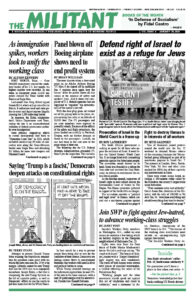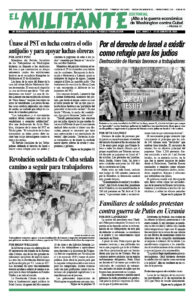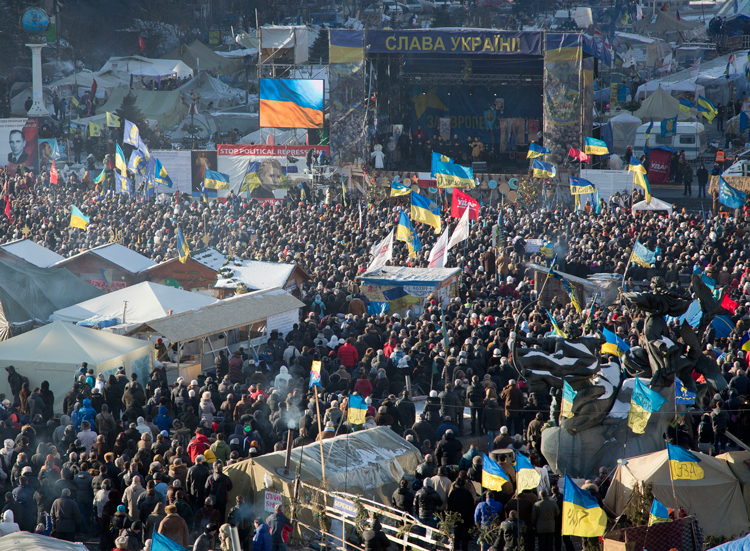As Moscow’s murderous war against Ukraine nears its third year, the Militant is running articles we wrote during and on the heels of the popular mass Maidan movement and Ukraine’s earlier history that led to the overthrow of the Moscow-backed regime of Viktor Yanukovych and advances for Ukraine’s independence. The excerpts below come from an article in the Feb. 3, 2014, issue, as protests against Yanukovych and Moscow exploded, drawing in thousands of workers.
Some 100,000 people demonstrated in Kyiv, Ukraine’s capital, Jan. 19 to demand repeal of new laws that curtail the right to protest. Underlying months of anti-government protests are national aspirations of the Ukrainian people, who — with the exception of the early years of the Russian Revolution — have lived for centuries under Russian domination.
Ukraine President Viktor Yanukovych pushed through the law in an attempt to undercut protests that began in November when he backed out of a deal to sign a trade and “association” agreement with the European Union and instead moved to maintain close economic and political ties with the government of Russian President Vladimir Putin.
Hundreds of thousands took to the streets, demanding that Yanukovych resign. A central slogan was, “Glory to Ukraine! Glory to the nation! Ukraine above all!”
The new law passed by Parliament last week bans the unauthorized public installation of tents or stages and use of loudspeakers in public and imposes jail terms for participating in “mass disorder” and wearing balaclavas or helmets.
Some protesters who fought with police defiantly wore saucepans and colanders on their heads. Some 1,500 protesters needed medical attention after the clashes.
The suppression of national rights in Ukraine goes back centuries. Eastern Ukraine became a possession of the Romanov Dynasty in 1654 and from that time on the feudal monarchy carried out a policy of Russification. While rule over the western part changed hands between Austria, Poland and Russia over centuries, the czars banned the Ukrainian language, suppressed the Ukrainian church and promoted Russian colonization in areas under its control.
By the early 1900s Ukraine made up 20% of the population of the Russian Empire. Russia was a “prison house of nations,” in the words of V.I. Lenin, central leader of the Bolshevik Party and 1917 Russian Revolution.
Lenin champions self-determination
The Ukrainian bourgeoisie remained small and weak. “In the Ukraine and White Russia [Belarus],” wrote Russian revolutionary leader Leon Trotsky in 1932, “the landlord, capitalist, lawyer, journalist, was a Great Russian, a Pole, a Jew, a foreigner; the rural population was wholly Ukrainian and White Russian.”
At the same time, Ukraine was a key conquest of the empire, serving as a breadbasket for Russia and major source of its coal and iron production.
Among the central tasks of the 1917 Bolshevik Revolution under Lenin’s leadership was the emancipation of tens of millions of oppressed peoples — from the culturally more advanced people of the Baltic region to the Muslims of the Caucasus to nomadic tribes of the Far East.
The Bolshevik Party’s championing of the right of oppressed nations to self-determination leading up to the revolution was decisive in uniting, educating and organizing the working class to take political power, which included forging an alliance with the peasant majority from all backgrounds.
The Central Committee of the Russian Communist Party stated in November 1919 that Bolsheviks in Ukraine “must put into practice the right of the working people to study in the Ukrainian language and to speak their native language in all Soviet institutions; they must in every way counteract attempts at Russification that push the Ukrainian language into the background.”
But by the early 1920s the degeneration of the Bolshevik Party had begun, personified by the rise to power of Joseph Stalin after the death of Lenin in 1924. Stalin headed a counterrevolution representing the interests of a growing privileged social layer centered in the increasingly bureaucratic state apparatus. This reactionary caste reversed the Bolsheviks’ course and resurrected the Great Russian chauvinism of the empire, including the re-subjugation of oppressed people.
“Nowhere did the purges and repression assume such a savage character as they did in the Ukraine,” Trotsky wrote in 1939.
When the Stalinist regime in Russia and Eastern Europe finally collapsed under pressure of growing social contradictions in the early 1990s, the new regime continued to dominate Ukraine.
Competing factions of emerging and aspiring capitalists arose following the collapse of the Soviet Union, drawn largely from remnants of the Soviet bureaucracy. In Ukraine, the factional contest was partially based on divisions of east and west, Russian and Ukrainian, orientation toward Moscow and the West. Meanwhile, the national aspirations among Ukrainian working people against the Russian boot remain strong.
At the end of 2004, in what became known as the Orange Revolution, hundreds of thousands of people, mostly from the western part of the country, took to the streets to oppose the continuing Russian domination of the country and what they saw as a rigged election that gave the presidency to Yanukovych, who was then prime minister.
As a result, a new election was called and bourgeois opposition candidate Viktor Yushchenko was elected president, taking office in 2005, but a series of corruption scandals left him with little support by the end of his term.
Yanukovych returned to the presidency after winning elections in 2010.


